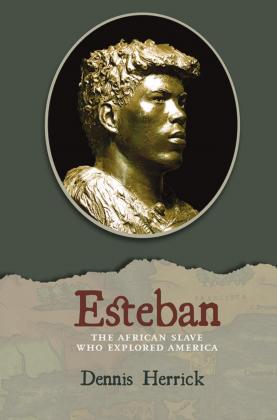Title: Esteban: The American Slave Who Explored America
Author: Dennis Herrick
Hardcover: 6-inch by 9-inch, 304 pages, 11 halftones and five maps
Published: October 2018
Publisher: UNM Press, www.unmpress.com
ISBN: 978-0-8263-5981-0
Author Dennis Herrick relied on exhaustive research to trace the Berber origins of a Moroccan resident and his role with the Spanish expeditions in the Western Hemisphere. The author dispels numerous myths and offers a fresh interpretation of the life of Esteban, who was in his mid-20s when he arrived in 1527 aboard a ship that was caught in a hurricane off the southern coast of present-day Cuba.
Slaves and servants were rarely referred to by name in Spanish historical documents. Esteban remains a rare exception. His linguistic talents and undying loyalty to his owner, Andres Dorantes de Carranza, earned him a place in the written annals of Spanish expeditions.
Herrick begins this book with Columbus, who in 1492 took possession of the first Caribbean island, now known as Hispaniola. His captain’s log includes an entry that stated, “certain that with these people I have with me, I can subjugate all the Indians.”
This prophecy was fulfilled, which led to a basic presumption by those who arrived in the following century, that Florida was an easy target for subjugation. This group of Spanish were fortune-seeking adventurers who assumed that all native tribes would succumb to European dominance just like the peaceful Tainos, who were the original inhabitants of the Caribbean islands.
Esteban and his owner, Andres Dorantes de Carranza, arrived in Florida near present-day St. Peters-burg as part of the 1528 Panfilo de Narvaez’ expedition. But the Apalachee warriors’ fierce defense of their homeland forced the Spanish to retreat. The surviving expedition members abandoned their campaign in Florida. They escaped in crude makeshift “boats” and hoped to cross the Gulf of Mexico; the survivors made landfall near presentday Galveston, Texas.
Only four of the original expedition, Esteban, Dorantes, Alvar Nunez Cabeza de Vaca, Alonso del Castillo Maldonado, survived the flight from Florida. They were enslaved by the Karankwa tribe for five years and ran away in 1534. Their escape path led the four men along the Gulf of Mexico in Texas; they then took a circuitous route through northern and western Mexico, and eventually arrived in present-day Mexico City in 1536.
Esteban’s skills as an interpreter, his affable demeanor, and striking physical appearance allowed the small band of survivors to establish friendly relationships with the various Native American tribes they encountered.
Esteban joined Friar Marcos in March 1539 as art of a roun that be an its travels in Culiacan, Mexico. This expedition was searching for the Seven Cities of Gold in what is now southwestern U.S.
“The first white man our people saw was a black man,” wrote Puebloan author Joe S. Sando.
Esteban arrived at the Zuni village, Hawikku, in western New Mexico in early May 1539 and disappeared from the historical record, according to Herrick.
The author emphasized that various published accounts of Esteban’s life often reflect the writers’ ethnocentricity and biased opinions. Most of the references written in the past five centuries about the Spanish slave portray him in a negative light.
But there were only three eyewitnesses who wrote about Esteban: Cabeza de Vaca, Dorantes, and Friar Marcos. None ever mentioned anything derogatory about him, according to Herrick.
There are few public spaces in the U.S. that recognize the Spanish slave who had converted from Islam to Catholicism prior to his arrival in the Western Hemisphere. One is a park in downtown Tucson, Arizona; another is in the Cabrillo National Monument visitor center in San Diego, California. The Moroccan native is also part of a mural inside the Arizona capitol building in Phoenix.
Esteban is credited as the first known Muslim to arrive in the United States by America’s Islamic Heritage Museum and Cultural Center in Washington, D.C.
“Esteban’s origins in Africa remain uncertain and are likely never to be documented,” wrote Herrick.
The author, Dennis Herrick, lives in Rio Rancho, New Mexico. His journalism career includes newspaper reporter, editor, and publisher. Herrick is a lecturer emeritus of journalism at the University of New Mexico. He has authored numerous articles and short stories, many of which focus on the Southwest and Native Americans. Herrick has written nine books including Winter of the Metal People, Hunting Season, and Shadows of a Lost Time in addition to his biography of Esteban and the African’s role in the history of the U.S.
Visit www.unmpress.com for more information.

